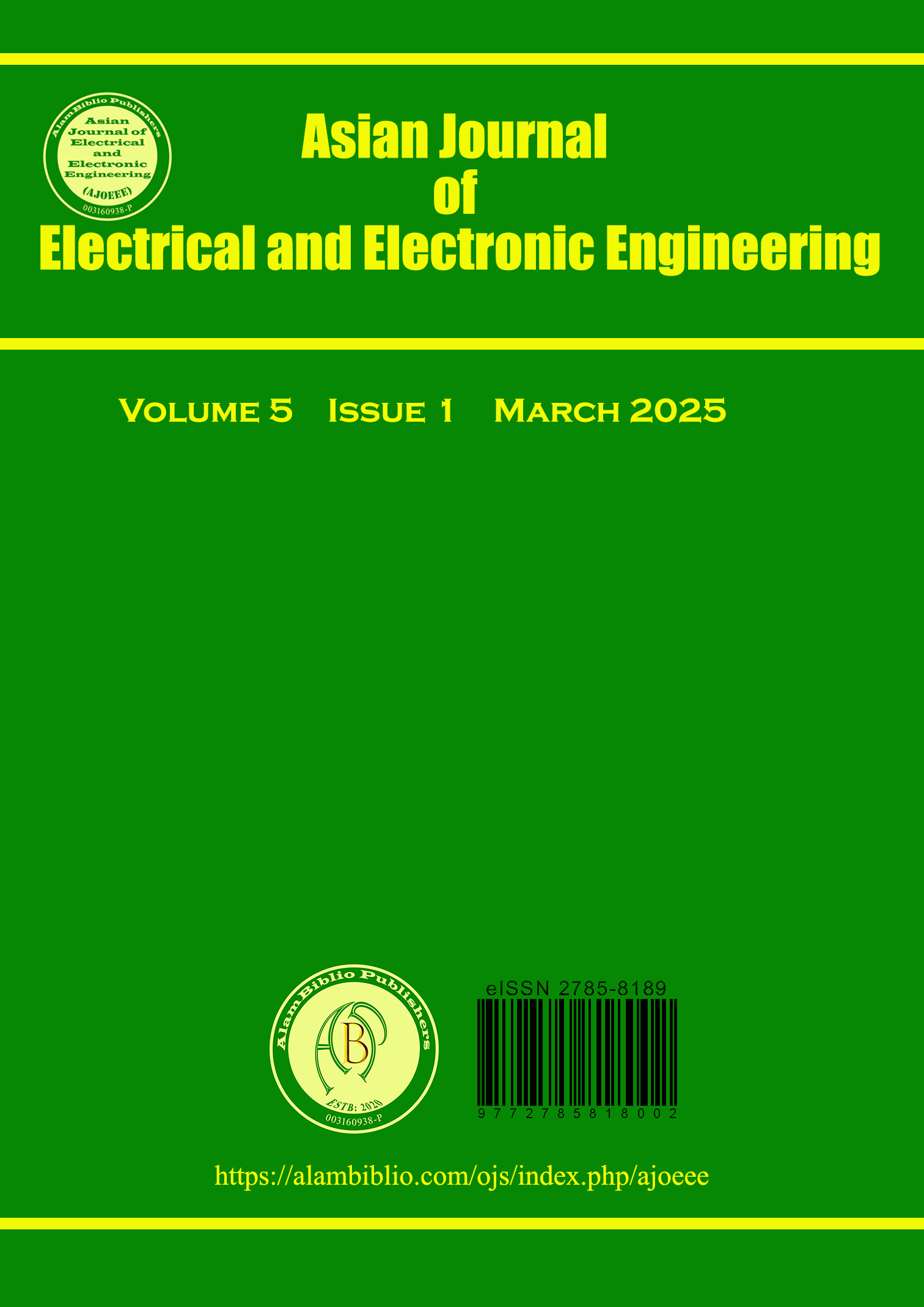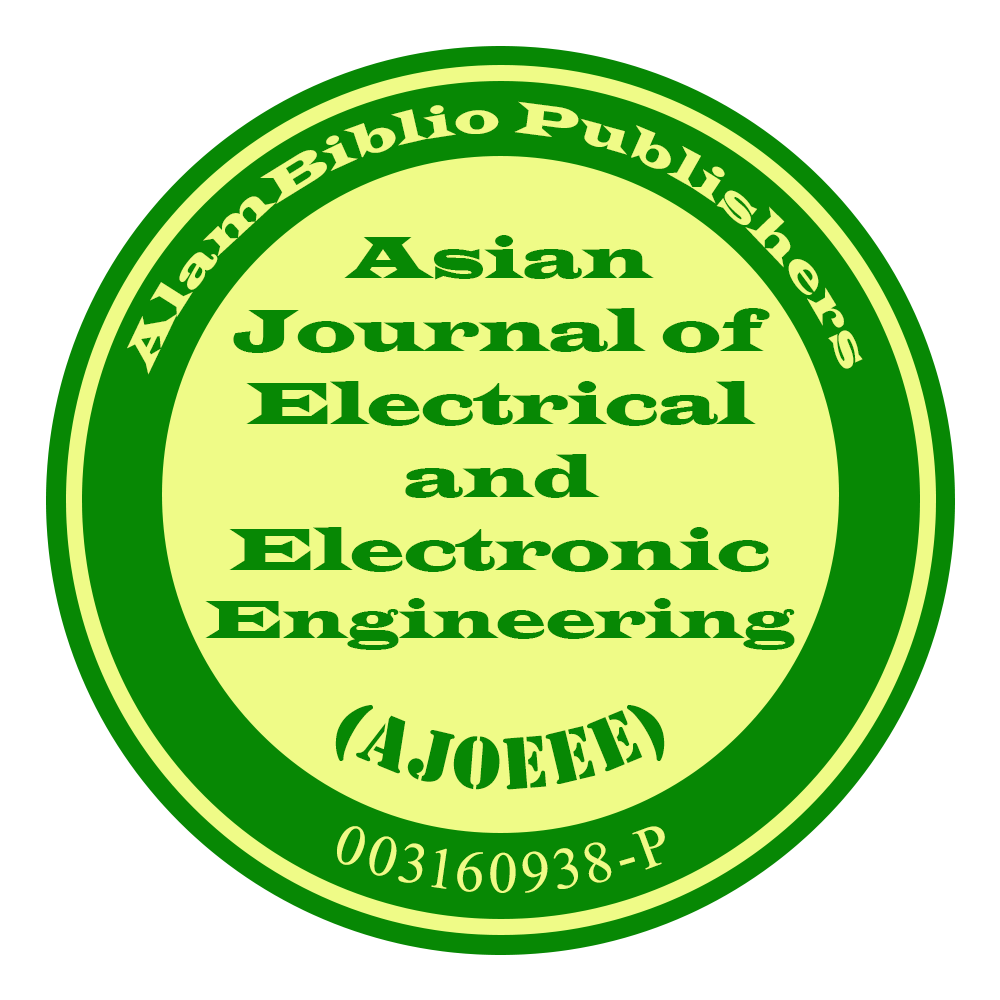Energy Efficiency Optimization in Algorithm for RIS-Assisted UAV-Enabled MEC-IoT Networks
DOI:
https://doi.org/10.69955/ajoeee.2025.v5i1.78Keywords:
RIs, UaVs, MECAbstract
The combination of drones and smart reconfigurable surfaces (RISs) is becoming increasingly important for improving energy efficiency and wireless communication performance in Internet of Things (IoT) networks. This research focuses on developing an iterative optimization algorithm based on the fmincon algorithm in MATLAB. Sensing and transmission parameters are updated simultaneously at each iteration to achieve maximum energy efficiency. The algorithm starts with initial values. To optimize the energy efficiency of a system integrating a drone that provides mobile edge computing (MEC) services to IoT devices, the proposed system takes into account several critical factors, including drone trajectory optimization, optimal bit allocation between local and drone processing, and phase shift optimization in smart reconfigurable surfaces. The goal is to maximize overall energy efficiency by jointly optimizing these elements through a novel algorithm that alternates between optimizing the smart reconfigurable surfaces' phase shifts, the drone trajectory, and bit allocation. Simulation results demonstrate that the proposed solution significantly outperforms other measurement approaches in terms of energy efficiency, while examining the impact of variables such as the number of users, the reflectance elements of reconfigurable smart surfaces, and base station antennas on system performance. In conclusion, this research presents a novel approach to enhancing energy efficiency in RIS-enabled and drone-enabled MEC systems for IoT networks, achieving significant improvements over existing methods.
Downloads
References
[1] I. Bala, A. Sharma, A. Tselykh, and B.-G. Kim, "Throughput optimization of interference limited cognitive radio-based Internet of Things (CR-IoT) network," J. King Saud Univ. Inf. Sci., vol. 34, no. 7, pp. 4233-4243, 2022. https://doi.org/10.1016/j.jksuci.2022.05.019 DOI: https://doi.org/10.1016/j.jksuci.2022.05.019
[2] R. Prakash and A. Balaji Ganesh, "Internet of Things (IoT) enabled wireless sensor network for physiological data acquisition," in International Conference on Intelligent Computing and Applications, 2019, pp. 163-170. https://doi.org/10.1007/978-981-13-2182-5_17 DOI: https://doi.org/10.1007/978-981-13-2182-5_17
[3] M. Ghamari, P. Rangel, M. Mehrubeoglu, G. S. Tewolde, and R. S. Sherratt, "Unmanned aerial vehicle communications for civil applications: A review," IEEE Access, vol. 10, pp. 102492-102531, 2022. https://doi.org/10.1109/ACCESS.2022.3208571 DOI: https://doi.org/10.1109/ACCESS.2022.3208571
[4] M. Dai, N. Huang, Y. Wu, J. Gao, and Z. Su, "Unmanned-aerial-vehicle-assisted wireless networks: Advancements, challenges, and solutions," IEEE Internet Things J., vol. 10, no. 5, pp. 4117-4147, 2022. https://doi.org/10.1109/JIOT.2022.3230786 DOI: https://doi.org/10.1109/JIOT.2022.3230786
[5] S. Ashtari Nakhaei, "Knowledge-Defined Routing Strategies for Next Generation Wireless Networks." 2023.
[6] T. M. Hoang, B. C. Nguyen, H. L. T. Thanh, X. N. Tran, and P. T. Hiep, "Finite Block Length NOMA MU Pairing UAV-enable system: Performance Analysis and Optimization," IEEE Trans. Mob. Comput., 2024. https://doi.org/10.1109/TMC.2024.3368159 DOI: https://doi.org/10.1109/TMC.2024.3368159
[7] N. Lin, Y. Fan, L. Zhao, X. Li, and M. Guizani, "GREEN: A global energy efficiency maximization strategy for multi-UAV enabled communication systems," IEEE Trans. Mob. Comput., vol. 22, no. 12, pp. 7104-7120, 2022. https://doi.org/10.1109/TMC.2022.3207791 DOI: https://doi.org/10.1109/TMC.2022.3207791
[8] Y. Zhang et al., "Machine Learning-Based Reliable Transmission for UAV Networks With Hybrid Multiple Access," IEEE Trans. Netw. Serv. Manag., 2024.
[9] M. Ahmed et al., "Active reconfigurable intelligent surfaces: Expanding the frontiers of wireless communication-a survey," IEEE Commun. Surv. Tutorials, 2024. https://doi.org/10.1109/COMST.2024.3423460 DOI: https://doi.org/10.1109/COMST.2024.3423460
[10] A. Narayanan et al., "Key advances in pervasive edge computing for industrial Internet of Things in 5G and beyond," IEEE Access, vol. 8, pp. 206734-206754, 2020. DOI: https://doi.org/10.1109/ACCESS.2020.3037717
https://doi.org/10.1109/ACCESS.2020.3037717 DOI: https://doi.org/10.1109/ACCESS.2020.3037717
[11] W. Khalid, M. A. U. Rehman, T. Van Chien, Z. Kaleem, H. Lee, and H. Yu, "Reconfigurable intelligent surface for physical layer security in 6G-IoT: Designs, issues, and advances," IEEE Internet Things J., vol. 11, no. 2, pp. 3599-3613, 2023. https://doi.org/10.1109/JIOT.2023.3297241 DOI: https://doi.org/10.1109/JIOT.2023.3297241
[12] G. K. Pandey, D. S. Gurjar, S. Yadav, Y. Jiang, and C. Yuen, "UAV-Assisted Communications With RF Energy Harvesting: A Comprehensive Survey," IEEE Commun. Surv. Tutorials, 2024. https://doi.org/10.1109/COMST.2024.3425597 DOI: https://doi.org/10.1109/COMST.2024.3425597
[13] X. Qin, Z. Song, T. Hou, W. Yu, J. Wang, and X. Sun, "Joint optimization of resource allocation, phase shift, and UAV trajectory for energy-efficient RIS-assisted UAV-enabled MEC systems," IEEE Trans. Green Commun. Netw., vol. 7, no. 4, pp. 1778-1792, 2023. https://doi.org/10.1109/TGCN.2023.3287604 DOI: https://doi.org/10.1109/TGCN.2023.3287604
[14] H. Hu, Y. Huang, G. Cheng, Q. Kang, H. Zhang, and Y. Pan, "Optimization of energy efficiency in UAV-enabled cognitive IoT with short packet communication," IEEE Sens. J., vol. 22, no. 12, pp. 12357-12368, 2021. https://doi.org/10.1109/JSEN.2021.3130581 DOI: https://doi.org/10.1109/JSEN.2021.3130581
[15] J. Ma, P. Chen, X. Xiong, L. Zhang, S. Yu, and D. Zhang, "Research on Vision-Based Servoing and Trajectory Prediction Strategy for Capturing Illegal Drones," Drones, vol. 8, no. 4, p. 127, 2024. https://doi.org/10.3390/drones8040127 DOI: https://doi.org/10.3390/drones8040127
[16] E. Trigui, M. Esseghir, and L. Merghem-Boulahia, "Multi-agent systems negotiation approach for handoff in mobile cognitive radio networks," in 2012 5th International Conference on New Technologies, Mobility and Security (NTMS), 2012, pp. 1-5. https://doi.org/10.1109/NTMS.2012.6208687 DOI: https://doi.org/10.1109/NTMS.2012.6208687
[17] X. Qin, W. Yu, Z. Song, T. Hou, Y. Hao, and X. Sun, "Energy efficiency optimization for RIS-assisted UAV-enabled MEC systems," in 2022 IEEE Globecom Workshops (GC Wkshps), 2022, pp. 1164-1169. https://doi.org/10.1109/GCWkshps56602.2022.10008478 DOI: https://doi.org/10.1109/GCWkshps56602.2022.10008478
[18] N. Crespi, W. Nagmeldin, and A. Abdelmaboud, "Vehicles Base Stations for Ad Hoc Networks," pp. 1-16, 2022.
[19] A. S. Parihar, K. Singh, V. Bhatia, C.-P. Li, and T. Q. Duong, "Performance Analysis of NOMA Enabled Active RIS-Aided MIMO Heterogeneous IoT Networks With Integrated Sensing and Communication," IEEE Internet Things J., 2024. https://doi.org/10.1109/JIOT.2024.3416951 DOI: https://doi.org/10.1109/JIOT.2024.3416951
[20] M. Diamanti, M. Tsampazi, E. E. Tsiropoulou, and S. Papavassiliou, "Energy efficient multi-user communications aided by reconfigurable intelligent surfaces and UAVs," in 2021 IEEE International Conference on Smart Computing (SMARTCOMP), 2021, pp. 371-376. https://doi.org/10.1109/SMARTCOMP52413.2021.00075 DOI: https://doi.org/10.1109/SMARTCOMP52413.2021.00075
[21] K. Lee, "Low-complexity transmit power control for secure communications in wireless-powered cognitive radio networks," Sensors, vol. 21, no. 23, 2021. https://doi.org/10.3390/s21237837 DOI: https://doi.org/10.3390/s21237837
[22] G. M. D. Santana, R. S. de Cristo, and K. R. L. J. C. Branco, "Integrating cognitive radio with unmanned aerial vehicles: An overview," Sensors (Switzerland), vol. 21, no. 3, pp. 1-27, 2021. DOI: https://doi.org/10.3390/s21030830
https://doi.org/10.3390/s21030830 DOI: https://doi.org/10.3390/s21030830
[23] A. Kumar, H. M. Alshahrani, F. Alotaibi, and A. Nanthaamornphong, "A hybrid detection algorithm for 5G OTFS waveform for 64 and 256 QAM with Rayleigh and Rician channels," Open Eng., vol. 14, no. 1, p. 20240008, 2024. https://doi.org/10.1515/eng-2024-0008 DOI: https://doi.org/10.1515/eng-2024-0008
[24] M. Abrar, U. Ajmal, Z. M. Almohaimeed, X. Gui, R. Akram, and R. Masroor, "Energy efficient UAV-enabled mobile edge computing for IoT devices: A review," IEEE Access, vol. 9, pp. 127779-127798, 2021. https://doi.org/10.1109/ACCESS.2021.3112104 DOI: https://doi.org/10.1109/ACCESS.2021.3112104
[25] S. Abeywickrama, R. Zhang, Q. Wu, and C. Yuen, "Intelligent reflecting surface: Practical phase shift model and beamforming optimization," IEEE Trans. Commun., vol. 68, no. 9, pp. 5849-5863, 2020. https://doi.org/10.1109/TCOMM.2020.3001125 DOI: https://doi.org/10.1109/TCOMM.2020.3001125
[26] J. Won, D.-Y. Kim, Y.-I. Park, and J.-W. Lee, "A survey on UAV placement and trajectory optimization in communication networks: From the perspective of air-to-ground channel models," ICT Express, vol. 9, no. 3, pp. 385-397, 2023. https://doi.org/10.1016/j.icte.2022.01.015 DOI: https://doi.org/10.1016/j.icte.2022.01.015
[27] H. Hu, Y. Huang, G. Cheng, Q. Kang, H. Zhang, and Y. Pan, "Optimization of Energy Efficiency in UAV-Enabled Cognitive IoT with Short Packet Communication," IEEE Sens. J., vol. 22, no. 12, pp. 12357-12368, 2022, doi: 10.1109/JSEN.2021.3130581. https://doi.org/10.1109/JSEN.2021.3130581 DOI: https://doi.org/10.1109/JSEN.2021.3130581
[28] M. S. Al-abiad, "Energy Efficient Communications in RIS-assisted UAV Networks Based on Genetic Algorithm".
[29] H. Xiao, S. Member, and X. Hu, "Energy-Efficient STAR-RIS Enhanced UAV-Enabled MEC Networks with Bi-Directional Task Offloading," pp. 1-14.
Downloads
Published
Issue
Section
License
Copyright (c) 2025 AlamBiblilo Publishers

This work is licensed under a Creative Commons Attribution-NonCommercial 4.0 International License.
The Asian Journal of Electrical and Electronic Engineering journal is licensed under a Creative Commons Attribution-NonCommercial 4.0 International License.










